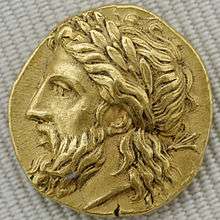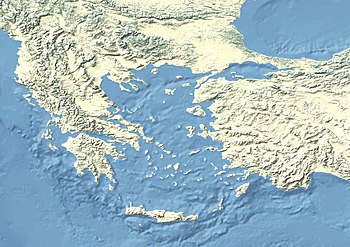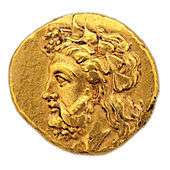Lampsacus
Lampsacus (/ˈlæmsəkəs/; Ancient Greek: Λάμψακος, romanized: Lampsakos) was an ancient Greek city strategically located on the eastern side of the Hellespont in the northern Troad.[1] An inhabitant of Lampsacus was called a Lampsacene. The name has been transmitted in the nearby modern town of Lapseki.
Λάμψακος | |
 | |
 Shown within the Aegean Sea area | |
| Alternative name | Pityusa, Pityussa, Lampsakos |
|---|---|
| Location | Lapseki, Çanakkale Province, Turkey |
| Region | Troad |
| Coordinates | 40°20′48″N 26°41′57″E |
| Type | Settlement |
| History | |
| Builder | Colonists from Phocaea and Miletus |
Ancient history
Originally known as Pityusa or Pityussa[2] (Ancient Greek: Πιτυούσ(σ)α), it was colonized from Phocaea and Miletus. In the 6th century BC Lampsacus was attacked by Miltiades the Elder and Stesagoras, the Athenian tyrants of the nearby Thracian Chersonese.[3] During the 6th and 5th centuries BC, Lampsacus was successively dominated by Lydia, Persia, Athens, and Sparta. The Greek tyrants Hippoclus and later his son Acantides ruled under Darius I.[4] Artaxerxes I assigned it to Themistocles with the expectation that the city supply the Persian king with its famous wine. When Lampsacus joined the Delian League after the battle of Mycale (479 BC), it paid a tribute of twelve talents, a testimony to its wealth; it had a gold coinage in the 4th century, an activity only available to the more prosperous cities.[5]
A revolt against the Athenians in 411 BC was put down by force. In 196 BC, the Romans defended the town against Antiochus the Great, and it became an ally of Rome; Cicero (2 Verr. i. 24. 63) and Strabo (13. 1. 15) attest its continuing prosperity under Roman rule. Lampsacus was also notable for its worship of Priapus, who was said to have been born there.
The philosopher Anaxagoras was forced to retire to Lampsacus after a trial in Athens around 434-33 BC. The citizens of Lampsacus erected an altar to Mind and Truth in his honor, and observed the anniversary of his death for many years.
Suda writes that the people of Lampsacus were pro-Persian and Alexander the Great was furiously angry, and threatened to do them massive harm. In order to save their women, children and homeland they asked from Anaximenes of Lampsacus, who was a tutor and historian of Alexander, to intercede. Alexander knew why he had come, and swore by the gods that he would do the opposite of what he would ask, so Anaximenes said, 'Please do this for me, your majesty: enslave the women and children of Lampsacus, burn their temples, and raze the city to the ground.' Alexander had no way round this clever trick, and since he was bound by his oath he reluctantly pardoned the people of Lampsacus.[6]
Lampsacus produced a series of notable historians and philosophers. Charon of Lampsacus (c. 500 BC) composed histories of Persia, Libya, and Ethiopia, and annals of his native town.[7] Metrodorus of Lampsacus (the elder) (5th century BC) was a philosopher from the school of Anaxagoras. Strato of Lampsacus (c. 335-c. 269 BC) was a Peripatetic philosopher and the third director of Aristotle's Lyceum at Athens. Euaeon of Lampsacus was one of Plato's students. A group of Lampsacenes were in the circle of Epicurus; they included Polyaenus of Lampsacus (c. 340 – 278 BC) a mathematician, the philosophers Idomeneus of Lampsacus, Colotes the satirist and Leonteus of Lampsacus; Batis of Lampsacus the wife of Idomeneus, was the sister of Metrodorus of Lampsacus (the younger), whose elder brother, also a friend of Epicurus, was Timocrates of Lampsacus. Anaximenes of Lampsacus, a rhetorician and historian. His nephew (son of his sister), was also named Anaximenes and was a historian.[8] Aristocles (Ἀριστοκλῆς) of Lampsacus was a stoic philosopher.[9]
Christian history
According to legend, St Tryphon was buried at Lampsacus after his martyrdom at Nicaea in 250.[10]
The first known bishop in Lampsacus was Parthenius, under Constantine I. In 364, the see was occupied by Marcian and in the same year a council of bishops was held at Lampsacus. Marcian was summoned to the First Council of Constantinople of Constantinople in 381, but refused to retract his adherence of the Macedonian Christian sect. Other known Bishops of Lampsacus were Daniel, who assisted at the Council of Chalcedon (451); Harmonius (458); Constantine (680), who attended the Third Council of Constantinople; John (787), at Nicaea; St. Euschemon, a correspondent of St. Theodore the Studite, and a confessor of the Faith for the veneration of images, under Theophilus. The See of Lampsacus is mentioned in the "Notitiae Episcopatuum" until about the 12th or 13th century.[11] The famous Lampsacus Treasure, now in the British Museum, dates from this period. The bishopric remains a vacant and titular see.[12]
See also
- List of ancient Greek cities
- List of traditional Greek place names
- Lampsace
- Anaximenes of Lampsacus
- Polyaenus of Lampsacus
- Metrodorus of Lampsacus (the younger)
- Abramios the Recluse
Notes
- Borza, E., DARMC, R. Talbert, J. Becker, S. Gillies, G. Reger, T. Elliott. "Places: 501570 (Pityoussa/Lampsacus)". Pleiades. Retrieved November 20, 2013.CS1 maint: multiple names: authors list (link)
- There were numerous pre-Hellenic or non-Hellenic places with this name, especially in modern Turkey and Greece Archived 2009-08-30 at the Wayback Machine: the pre-Hellenic name of Miletus of the Leleges was also Pityussa (Strabo, 14.1.3); Spetses' ancient name was Pityoussa; during the Roman Civil Wars Sertorius with some Cilician pirates effected a landing at an island of Pityussa on the North African coast of Mauretania, and was driven off (Plutarch, Life of Sertorius 7).
- Herodotus 6.37-38
- Tuplin, Christopher (2007). Persian Responses: Political and Cultural Interaction with(in) the Achaemenid Empire. ISD LLC. p. 126. ISBN 9781910589465.
- Asia Minor Coins – ancient coins of Lampsacus
- Suda, § al.1989
- J. B. Bury, The Ancient Greek Historians, Lecture 1, §4.
- Diogenes Laertius, Lives of the Philosophers, § 2.3
- Suda, al.3917
- Herbermann, Charles, ed. (1913). . Catholic Encyclopedia. New York: Robert Appleton Company.
- Herbermann, Charles, ed. (1913). . Catholic Encyclopedia. New York: Robert Appleton Company.
- Lampsacus at catholic-hierarchy.org.
